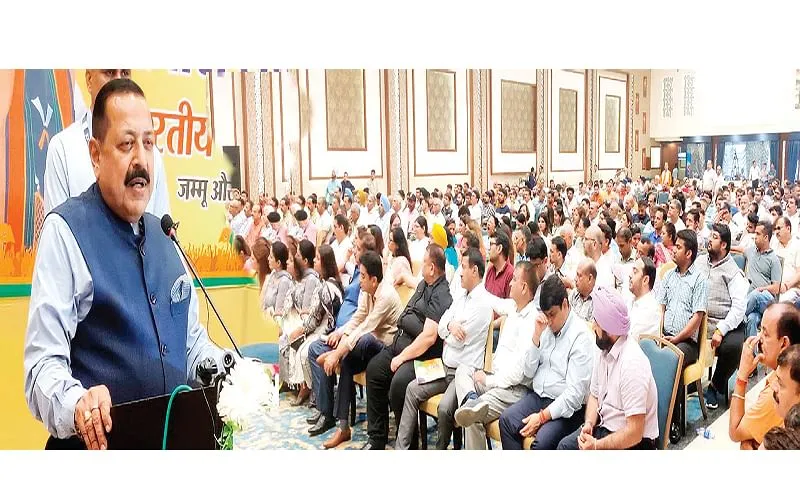On March 17 Dr Jitendra Singh, Minister of State (Independent Charge) for Science and Technology (among other charges) released a document entitled “India and the Artic: Building a Partnership for Sustainable Development”; it lays out the objectives and activities envisaged within India’s Artic Policy. While India’s engagement with the Artic region has been ongoing for many years, the area is far removed from the Indian consciousness. It would not be an exaggeration to state that India’s political and strategic classes have only a nebulous idea of its growing importance in global geo-politics and the impact of climate change on the region which in turn is having major repercussions on the planet. It is good that Indian scientists have been involved in the study of the Artic region. A large number of institutes are engaged and papers are being published. This activity needs not only to be maintained but also augmented.
The initiative to bring the country’s Artic Policy to public attention has been timely though it would have been better if it had been done earlier. For, in an article in June 2013 (the year India joined the Artic Council as an observer country) the Public Diplomacy Division of the External Affairs Ministry noted: “Artic region, the enormous area around the North Pole spreading over one-sixth of the Earth’s landmass (approximately the size of Russia, China and India put together!) is increasingly being effected by external global forces—environmental, commercial and strategic and in turn is poised to play an increasingly greater role in shaping world affairs”. This aptly sums up the significance of the region and underlines the need for substantial and steady Indian attention.
The global media has periodically reported on the adverse impact of climate change on the Artic region, especially on the reduction of ice-caps. Dramatic pictures and videos of masses of ice breaking off and the formation of pools and even lakes on account of rising temperatures appear from time to time. There is only a faint notion that all this also concerns India too. The document released by Jitendra Singh goes much further and spells it out. It candidly and sombrely notes “India is particularly impacted due to the likely effect of these changes on critical aspects of national development such as economic security, water security and sustainability, weather conditions and monsoon patterns, coastal erosion and glacial melting”. The cumulative impact of these adverse developments—if they come to pass and the scientists have issued warning after warning that they will—shall be devastating.
The need of the time is therefore that great priority is given to undertaking policies and actions, even if they be economically and politically painful, that will be adaptive and mitigatory. For this purpose the political class needs to come together. It may be helpful if an initiative is taken to bring all aspects of climate change on India, including through the changes taking place in the Artic region, to the collective attention of political leaders so that they can unitedly agree on the measures that have to be taken. The Ministry of Earth Sciences along with others would therefore be doing the country a great service if its scientists along with outside experts undertake an initiative to reach out to the political and strategic classes through a series of workshops to bring the importance of the Artic region to India in focus.
The melting of Artic ice is going to open up channels of shipping via the northern-eastern route. This will provide opportunities to Russia and Asian countries like China and Japan to channel their shipping, to begin with, for at least a part of the year. Much of this is futuristic but major countries like India have to plan for the future to study not only the impact of these developments on shipping but the geo-strategic consequences of the opening up of the Artic region to the Indo-Pacific. In addition to navigation, the document states that there will be possibilities in “energy exploration, mining and food security”. It would be prudent to seek to remain ahead of the curve in these areas through building partnerships with member-states of the Artic Council. These are Canada, Russia, the US, Finland, Iceland, Norway and Sweden.
Indian initiatives in the Artic region are part of its polar programme whose activities extend to Antarctica and the Himalayas as well. Indian scientists have done good work on different aspects of the Himalayas which are vital for India’s well-being. It is not often recalled but the Antarctica initiative began in 1981. In the four decades since then Indian involvement in Antarctica studies has grown. India has two operational research stations and has undertaken 40 scientific expeditions. This is a creditable record.
These Antarctica initiatives are part of commitment made by the leadership in the early years of the country’s independence that India will make every effort to reach the frontier areas of science and technology. There was an acute consciousness among some of the leaders of the Indian freedom movement, especially Jawaharlal Nehru, that India’s colonisation was ultimately on account of lagging behind Europe in science and technology. There were of course socio-economic, political and cultural factors which led to this situation but the end result was the atrophying of a desire to gain authentic knowledge. Amidst the fundamental clash of ideologies which is taking place currently in the country the debt it owes to the vision of Nehru to build the scientific and the technological base of the country should not be forgotten.
Disclaimer: The views and opinions expressed in this article are the personal opinions of the author. The facts, analysis, assumptions and perspective appearing in the article do not reflect the views of GK.







